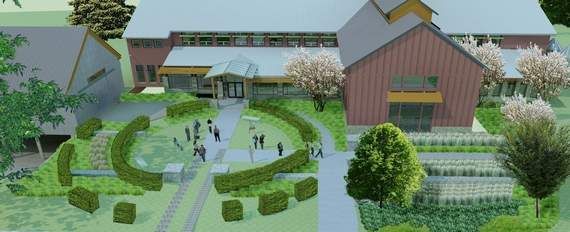Foster's Daily Democrat, Monday, August 20, 2012
[The following article is courtesy of the Foster's Daily Democrat]

Smuttynose Brewing Company celebrated the start of the first phase of construction of its new brewery with a groundbreaking on Towle Farm Road on Thursday. [Courtesy photo]
HAMPTON -- On Thursday, Smuttynose Brewing Company celebrated the start of the first phase of construction of its new brewery designed by McHenry Architecture with a groundbreaking on Towle Farm Road.
The project will result in a LEED-certified facility that will greatly increase the efficiency and capacity for the production of its brews with the ability to expand capacity when needed. The 14-acre property and former site of the historic Towle Farm will be transformed into a state-of-the-art brewery complex. Integral to the design of the brewery is the preservation of the existing barn for future use and the relocation of the Victorian era farmhouse to be renovated for use as a restaurant along the eastern slope of the site.
The main brewery building (34,425 square feet) consists of complete facilities for the brewing, bottling, storing and shipping of Smuttynose beers and will include offices, a gift shop and an entry gallery that will allow the public to view the operations and take tours of the facility. Great care has been taken to minimize the impact of the building on the site. Vehicular access, circulation and parking is carefully considered within the greater landscape design, which preserves open space and the historic nature of the site.
McHenry Architecture PLLC of Portsmouth is the architect for the project and assembled a highly experienced team of engineering consultants to complete the design, including Altus Engineering, civil engineering, terra firma landscape architects, JSN, Inc., structural engineering, Mechanical Systems Engineers, mechanical and plumbing engineering, Electrical Design Consultants, electrical engineering, the Sparhawk Group, commissioning agent and The Green Engineer, LEED Certification consultants. Harvey Construction Corporation of Bedford is building the project.
The project has been designed to achieve US Green Building Council's LEED Gold certification.
The site design takes into account maximizing open space, utilizing a previously developed site, innovative stormwater design and alternative parking and bicycle storage. The landscape design features rain gardens to help control storm water runoff and the restoration of the old apple orchard on the site.
Water efficiency goals are achieved by selection of plantings that do not require irrigation and by the use of water efficient fixtures and an overall reduction of water use that is greater than 30% of the standard for buildings of this type.
Energy performance will be improved by combining a carefully designed and well-insulated building shell and the use of high efficiency heating and cooling systems. The primary building cladding material is an insulated metal panel system and a stone veneer and generous glazing completes the areas in public view. A monumental light monitor along the ridge of the main brewing wing will flood the industrial interior in natural light, while a series of solar tubes and translucent panels in the storage areas lessen the need for artificial lighting.
Building material selection goals will be achieved by choosing regional materials, certified wood products and other materials with recycled content and by the diligent management of construction waste. Portions of the old carriage house were carefully deconstructed and saved for future use and mature trees on the site were milled for use in interior finishes and restaurant furniture.
Indoor environmental quality goals will be achieved by committing to higher standards of fresh air and ventilation, thermal comfort controls, increased daylighting and by choosing interior finishes that are certified to have low content of harmful chemicals. A simple but effective example of building energy reduction involves integrating the hot water used for the brew process with the building mechanical systems. Heat that would normally be wasted during brewing supplements heating systems for the building.
Other LEED credits come from innovative design considerations that include the use of the facility as an educational tool and by the use of LEED accredited professionals during the process. Creative environmental graphics will assist the public and encourage people to wander the site and learn how it was developed with sustainable design principles in mind.The facility is also designed to include an on-site renewable energy system, powered by the recycled waste product of the brewing process. An anaerobic biomass digester tank captures waste water from brewing and produces methane gas that powers an on-site electric generator. The system also lowers the overall organic content of the wastewater, lessening its impact on the municipal sewage system.
The design of the buildings is strongly influenced by the historic nature of the existing site. The experience of the traditional forecourt formed by the original farm buildings is maintained with the new brewery design. Most of the parking and truck loading areas are placed to the rear of the building to maintain a welcoming public space at the front of the building.
Repurposing of the farmhouse building by moving it over 200 feet to the east on a new foundation allows for its use as a pub and restaurant and gateway to the complex. In general, the design has evolved from its context, such that the building form is in the agrarian vernacular while its function is modern, efficient and environmentally responsible. The owners and the entire design team remained committed to the principles of Sustainable Design from the beginning of the project.

A rendering of the new brewery. [Courtesy artwork]
